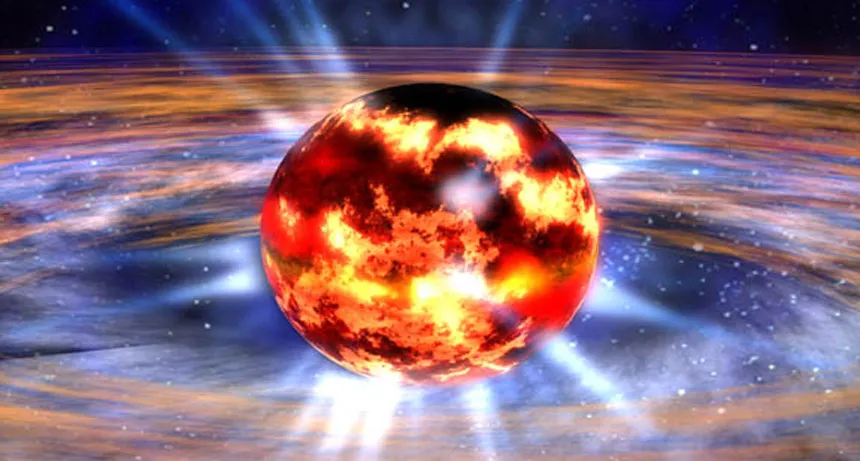
GETTING CHILLS After swiping material from a partner star, a neutron star (illustrated) quickly cooled off by spewing out particles called neutrinos.
Dana Berry/NASA
- More than 2 years ago
For some neutron stars, the quickest way to cool off isn’t with a frosty beverage, but with lightweight, subatomic particles called neutrinos.
Scientists have spotted the first solid evidence that some neutron stars, the collapsed remnants of exploded stars, can rapidly cool their cores by emitting neutrinos. The result adds to evidence that scientists are gathering to understand the ultradense matter that is squished deep within a neutron star’s center.
The new evidence comes from a neutron star that repeatedly gobbled material from a neighboring star. The neutron star rapidly cooled off after its meals, scientists determined. X-rays emitted by the neutron star showed that the fast cooldown rate was consistent with a theorized effect called the direct Urca process, in which neutrinos quickly ferry energy away from a collapsed star, astrophysicist Edward Brown and colleagues report in the May 4 Physical Review Letters.
Neutron stars are known to emit neutrinos by a similar process that cools the star slowly. But previously, there wasn’t clear evidence for faster cooling. The team analyzed observations of the neutron star, located about 35,000 light-years from Earth, as it cooled during a 15-year interlude between feeding sessions. Neutrinos carried away energy about 10 times faster than the rate energy is radiated by the sun’s light — or about 100 million times quicker than the slow process, says Brown, of Michigan State University in East Lansing.
Although some other neutron stars have shown hints of such a quick chill, “this is basically the first object for which we can see the star actively cooling before our eyes,” says astrophysicist James Lattimer of Stony Brook University in New York, who was not involved with the research.
The direct Urca process, named by physicists George Gamow and Mário Schenberg in the 1940s, took its moniker from the now-defunct Urca casino in Rio de Janeiro. “The joke being that this process removes heat from the star the way the casino removes money from tourists’ pockets,” Brown says.
In the process, neutrons in the star’s core convert into protons and emit electrons and antineutrinos (the antimatter partners of neutrinos). Likewise, protons convert into neutrons and emit antielectrons and neutrinos. Because neutrinos and antineutrinos interact very rarely with matter, they can escape the core, taking energy with them. “The neutrino is a thief; it robs energy from the star,” says physicist Madappa Prakash of Ohio University in Athens, who was not involved with the research.
The observation may help scientists understand what goes on deep within neutron stars, the cores of which are squeezed to densities far beyond those achievable in laboratories. Although the simplest theory holds that the cores are crammed with neutrons and a smaller number of protons and electrons, scientists have also proposed that the collapsed stars may consist of weird states of matter, containing rare particles called hyperons or a sea of free-floating quarks, the particles that make up protons and neutrons (SN: 12/23/17, p. 7).
The direct Urca process can happen only if the fraction of protons in the center of the neutron star is larger than about 10 percent. So if the process happens, “that already tells us a lot,” says astrophysicist Wynn Ho of Haverford College in Pennsylvania, who was not involved in the research. Such observations could eliminate theories that would predict lower numbers of protons.
However, the scientists weren’t able to determine the mass of the neutron star, limiting the conclusions that can be drawn. But, says Prakash, if the mass of such a quickly cooling neutron star is measured, the neutron star’s interior makeup could be nailed down.







